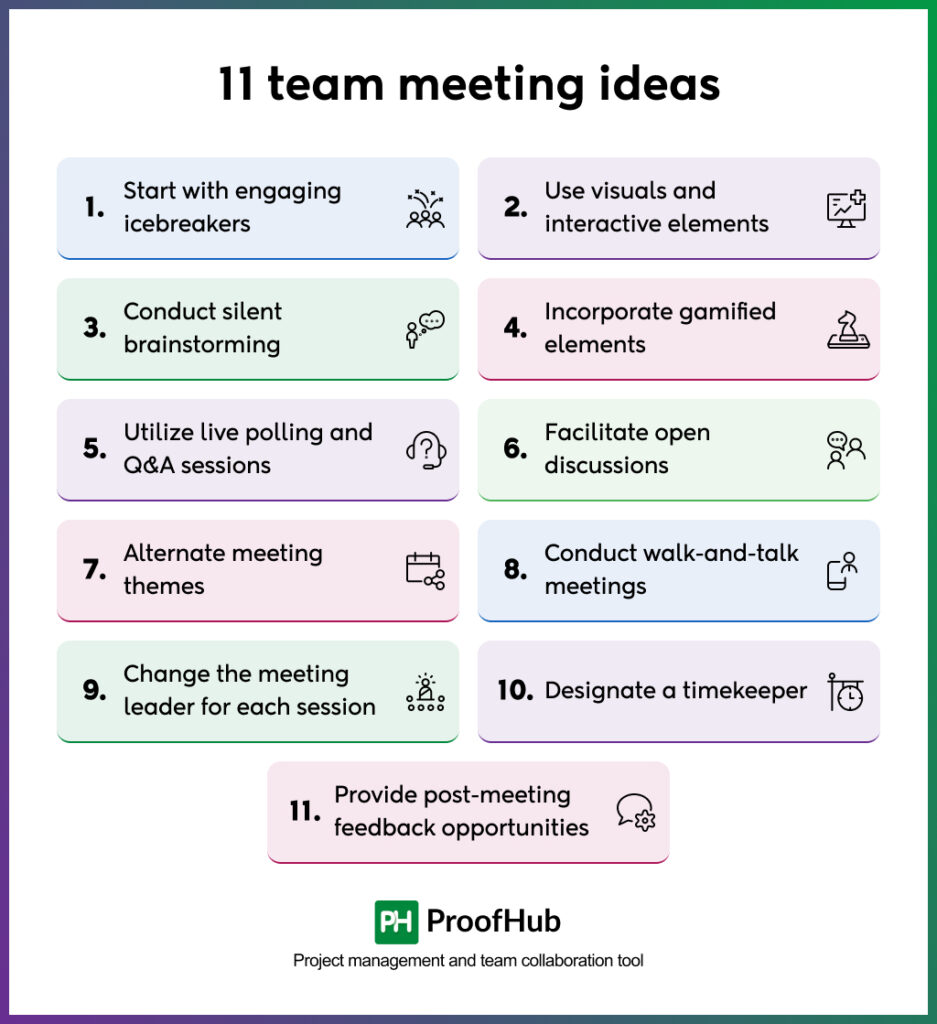Most team meetings feel more like a snooze button than a spark plug.
You know the signs: distracted faces, minimal participation, and energy levels that are barely engaged.
But meetings don’t have to be the most disengaged part of the day. When done right, they can be energizing, collaborative, and even fun, with a space where ideas ignite, teams align, and momentum builds.
A quote by business management author Patrick Lencioni:
“If you’re not interested in engaging your people, you’re not interested in leading them.”
This struck a chord, and determined to make a change, I began experimenting with unconventional meeting ideas that energized my teammates. Some ideas worked better, and gradually, a visible transformation occurred. Meetings became more engaging, and team members were more energetic.
Drawing from these experiences and approaches, here is a list of 11 innovative team meeting ideas. These strategies are easy to implement and can help turn your meetings into productive and enjoyable gatherings.
Why most meetings fall flat
Most meetings don’t fail because of the agenda and preparation. They fail because they lack intention, engagement, and relevance. Here are the top reasons why most meetings fail.
1. No visual or interactive elements
A discussion without visuals or employee engagement activities makes meetings dull. Without something to look at or take part in, employees lose focus quickly. It becomes harder for attendees to stay mentally present, and important information often goes unnoticed and forgotten.
2. Fear of speaking up
A lack of psychological safety and fear of being judged or dismissed can prevent team members from engaging fully. Without a safe space, silence becomes the norm. Even when employees have valuable insights or concerns, they may hold back if they feel their ideas won’t be respected or taken seriously.
3. Meetings that drag on too long
Attention spans shrink when meetings run longer than necessary or lack clear time management. Long meetings without defined breaks or energy shifts drain focus and reduce the effectiveness of any discussion. Over time, team members may start viewing meetings as time-wasters instead of collaboration opportunities.
Also read: How to stop wasting time in meetings and start getting real work done
4. No follow-through
Decisions made in meetings often die in silence without proper follow-ups or accountability, making employees question the point of the meeting at all. When action items aren’t tracked or revisited, momentum is lost, and trust in the meeting process erodes.
11 team meeting ideas to spice up your meetings
If you are bored with your regular meetings or think your team members are not engaged, then add some spice to them. Here are 11 innovative ideas for team meetings that can help you make your meetings (In office or virtual) more energetic and engaging:

1. Start with engaging icebreakers
Incorporating icebreakers should be a top priority for any manager exploring creative meeting ideas. Kick off your meeting with a light, engaging activity to energize the team and set a positive tone for collaboration. It could be a quick round of “Two Truths and a Lie” or a simple question like, “What’s your favorite movie snack?”.
Allow each person to answer so that everyone participates.
If you want formal icebreaker ideas, you can opt for the following questions:
- “Two-word check-in,” where each person shares how they’re feeling in two words.
- “Win of the Week,” where everyone shares one professional (or personal) win in 10 seconds.
- “One-word goal” – Each team member says one word describing their focus for the week.
Try rotating the icebreaker responsibility each week so everyone gets involved in leading. You can use a spinner wheel to pick one at random.
Over time, this small habit can boost engagement, team dynamics, and productivity.
2. Use visuals and interactive elements
Most people understand and remember information better when they see it rather than just hear it. That’s why incorporating visuals, such as infographics, flowcharts, videos, and slides, is one of the best team meeting ideas to boost engagement and clarity during meetings.
Supporting this approach, a research paper published on the Social Science Research Network (SSRN) notes that 65% of people are visual learners, meaning they retain information better when it’s presented in a visual format (source).
Here to use visuals for interactive meetings
- Infographics: Perfect for simplifying and visually presenting complex data, ideas, or strategies at a glance.
- Flowcharts: Ideal for mapping out processes, workflows, and decision trees in a clear, logical format.
- Slideshows: Great for structuring your presentation and walking the audience through ideas and key points step by step.
- Videos: A dynamic way to capture attention, explain concepts, and make your message more memorable and engaging.
3. Conduct silent brainstorming
Embracing silence during brainstorming helps teams produce more energy in team meetings. Silent brainstorming can be particularly useful in remote meetings.
How to conduct a silent brainstorming session
- Start with silent ideation (10–20 minutes)
- Ask team members to write their ideas directly into the shared document without speaking or discussing.
- If the team is small, review the ideas together and discuss promising directions in real time.
- For bigger teams, close the session after the silent phase. Later, review the ideas, identify themes, and share a summary with the next steps via email or chat.
Also read: 13 Brainstorming techniques for collaborative teams
4. Incorporate gamified elements
Gamification is a collaborative work meeting ideas that can significantly boost engagement and participation. These fun meeting ideas for work turn routine meetings into interactive experiences that your team looks forward to
Games you can try
- Leaderboard challenges: Track small wins or task completions across the team and show progress during meetings.
- Trivia quizzers: Create short quizzes related to the meeting topic to reinforce learning and make it more fun.
- Spin the wheel rewards: Recognize contributions or ideas during the meeting with randomized digital rewards(like a virtual prize wheel).
5. Utilize live polling and Q&A sessions
An easy way to enhance the interactivity in your team meetings is to run live polls. These polls are fun meeting ideas for work, breaking the monotony and ensuring everyone has a voice, especially team members who hesitate to speak up.
Moreover, live Q&A sessions allow participants to ask anonymous questions or upvote the most relevant ones, making discussions more democratic and transparent.
How to utilize live polling in team meetings:
- Start with a clear question: Ask a short question that helps gather opinions or check understanding, for example, “Are we ready to move forward with this project?”
- Keep it quick and interactive: Let team members vote in real-time. Share the results right away to spark a short discussion.
- Use the results to guide decisions: Don’t let the data sit idle. If a poll shows confusion or disagreement, take the time to clarify things.
6. Facilitate open discussions
When team members feel safe to share their thoughts, ideas, or concerns, it leads to more diverse input, better problem-solving, and stronger team alignment. Instead of just presenting updates, create space for everyone to contribute and be heard.
How to facilitate open discussion
- Guide the conversation: Let everyone speak by asking open questions and making sure no one takes over the talk. Help the discussion flow without controlling it.
- Start with a Quick Icebreaker: Begin with a simple question or fun activity to help everyone feel relaxed and ready to share.
- Keep it organized: Use an agenda and set time limits. Stick to the plan so the conversation stays on track and covers all important topics.
7. Alternate meeting themes
Another effective way to boost team engagement and energy is by introducing alternate meeting themes. Giving each meeting a unique energy keeps things fresh and signals that you value creativity and team morale.
According to the studies by PubMed Central, when people are exposed to something new, it boosts both verbal and visual memory retention for days afterwards.
How to alternate meeting themes
- “No Slides Day”: No presentations allowed, only discussion.
- “Retro Fridays”: Share a story or favorite tool from your early workdays.
8. Conduct walk-and-talk meetings
Not all meetings need to happen around a conference table. Walk-and-talk meetings are a refreshing alternative to traditional sit-downs, especially for one-on-one check-ins, brainstorming sessions, or quick standups.
According to Stanford research, walking can increase creative output by up to 60%, making it a powerful way to spark ideas and solve problems more organically.
How to make walk-and-talk meetings effective:
- Choose topics that don’t require screens or heavy notes, think brainstorming, quick feedback, or relationship-building.
- Limit the group size (ideally 2–3 people) to keep the conversation fluid.
- Set a time limit, 10 to 15 minutes works best.
- Use a voice recorder app or take quick notes on your phone if needed.
9. Change the meeting leader for each session.
When different team members take turns leading meetings, it does more than just switch up the energy. It encourages shared ownership, surfaces new perspectives, and boosts the energy of the team members.
This approach is also backed by science. A study published in the Proceedings of the National Academy of Sciences found that teams alternating between collaborative and individual phases produced higher-quality solutions than those who worked only collaboratively or independently.
How to implement role-switching effectively
- Create a calendar assigning hosting duties to different team members.
- Offer resources or training to help new hosts prepare for their role.
- After each meeting, solicit feedback to help hosts improve and adapt.
10. Designate a timekeeper
Even the best meetings can derail without one essential element: time discipline. A simple but powerful fix? Assign a dedicated timekeeper. This person isn’t there to rush conversations but to gently guide the group to stay aligned with the agenda and respect everyone’s time.
How to designate a timekeeper in a meeting
- Avoid random assignments: Randomly assigning the role can lead to a less engaged or effective timekeeper.
- Choose wisely: The ideal timekeeper should be someone who can focus on time management without being actively involved in the discussion.
- Consider a volunteer: It’s often a good idea to ask for volunteers or have someone express an interest in the timekeeping role.
- Explain the role: Clearly define what the timekeeper’s responsibilities are, such as keeping track of time and providing reminders.
- Utilize meeting management tools: With meeting management tool, you can create meeting minutes, attach them to specific projects, and invite attendees to collaborate in real time.
Read more: Top 11 meeting minutes software for effective meetings in 2025
11. Provide post-meeting feedback opportunities
Post-meeting feedback creates a continuous improvement loop where team members feel heard and valued, and it helps you identify what worked and what did not.
How to ask for feedback after the meeting
- End every meeting with a quick feedback prompt, for instance, what could we do better next time?
- Use tools like Google Forms to get post-meeting feedback, or if you are using ProofHub, you can have built-in forms too!.
- Acting on the suggestions lets your team see that their input leads to improvements and their voice is heard in the organization.
Also read: 13 Tips for running the most effective team meetings
Conclusion
Low engagement in meetings isn’t just a small problem; it can seriously hurt your team’s productivity and motivation. When people feel disconnected, they stop participating, and meetings lose their purpose.
To bring energy back into your meetings, try engaging team meeting ideas like walk-and-talk meetings or cutting out unnecessary information requests. Using team management tools can also make a big difference by helping you organize better, keep everyone on the same page, and encourage active participation.
With the right team meeting engagement ideas, your meetings can become more than just another task; they can drive real collaboration and results.
Frequently asked questions
How can team meeting activities improve collaboration and communication?
Unique team meeting ideas like icebreakers and open discussions break down communication barriers and build trust. They:
- Encourage everyone to speak up, especially quieter team members.
- Help teams better understand different working styles and perspectives.
- Create shared experiences that strengthen team rapport.
- Promote active listening and mutual respect, leading to smoother collaboration.
Can team meeting ideas impact productivity?
Yes, engaging meeting formats directly impact productivity by turning passive attendance into active contribution. When meetings are:
- Structured yet interactive (with agendas, breakout groups, or polls),
- Focused on outcomes (instead of just status updates),
- And inclusive of everyone’s ideas,
- They become action-oriented. That reduces time wasted in unclear conversations and boosts clarity, motivation, and follow-through.
How do I keep my team interested during regular meetings?
It starts with variety and purpose. Here’s how:
- Alternate formats (e.g., walk-and-talks, gamified quizzes, themed days).
- Rotate facilitators to bring fresh energy.
- Keep meetings short, visual, and focused.
- Start with an engaging icebreaker or personal check-in.
- End with clear action items and feedback loops.

